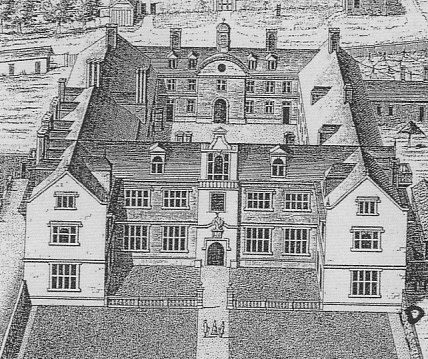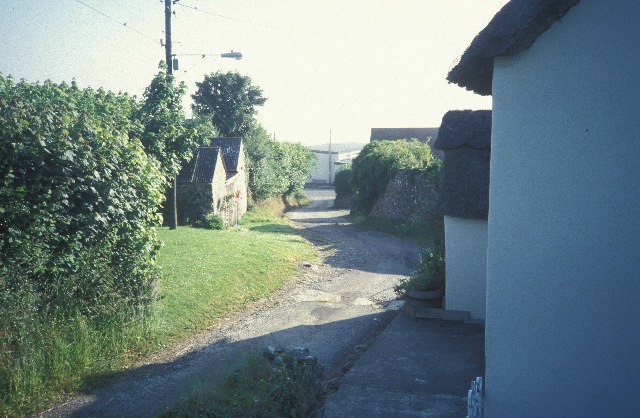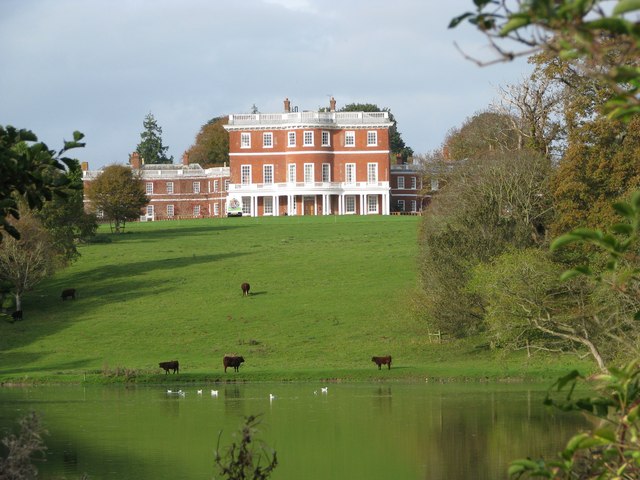|
Heanton Satchville, Huish
Heanton Satchville is an estate in the parish of Huish in Devon. It took its name from the nearby former ancient estate of Heanton Satchville, Petrockstowe. It is the seat of Baron Clinton who owns the largest private estate in Devon, known as Clinton Devon Estates. History In 1797, shortly before the early death of Robert Trefusis, 17th Baron Clinton (1764–1797) at the age of 33, his ancient and grand mansion house at Heanton Satchville in the parish of Petrockstowe in Devon, burned down. His wife died a year after him, leaving a 10 year-old son and heir Robert Trefusis, 18th Baron Clinton (1787–1832), without a habitable residence. In 1812, on reaching his majority of 21, he purchased the manor of Huish, including the recently built mansion house known as Innes House, situated to the east across the valley from the destroyed Heanton Satchville. He abandoned the burnt-down house, which was razed to the ground without trace, renamed Innes House as "Heanton Satchville", an ... [...More Info...] [...Related Items...] OR: [Wikipedia] [Google] [Baidu] |
Huish, Torridge
Huish (anciently ''Hiwis'') is a small village, civil parish and former manor in the Torridge district of Devon, England. The eastern boundary of the parish is formed by the River Torridge and the western by the Rivers Mere and Little Mere, and it is surrounded, clockwise from the north, by the parishes of Merton, Dolton, Meeth and Petrockstowe. In 2001 the population of the parish was 49, down from 76 in 1901. The village lies just off the A386 road, about five and a half miles north of Hatherleigh, and about seven miles south of Great Torrington. It was a member of the historic hundred of Shebbear and was in the deanery of Torrington. The majority of the parish consists of parkland belonging to Heanton Satchville, the seat of Baron Clinton; the mansion-house is a few hundred yards to the north of the church. Parish church The church, dedicated to St James the Less, was heavily restored in 1873 by the 20th Baron Clinton to the designs of George Edmund Street. The work ... [...More Info...] [...Related Items...] OR: [Wikipedia] [Google] [Baidu] |
Heanton Satchville, Petrockstowe
Heanton Satchville was a historic manor in the parish of Petrockstowe, North Devon, England. With origins in the Domesday manor of Hantone, it was first recorded as belonging to the Yeo family in the mid-14th century and was then owned successively by the Rolle, Walpole and Trefusis families. The mansion house was destroyed by fire in 1795. In 1812 Lord Clinton purchased the manor and mansion of nearby Huish, renamed it Heanton Satchville, and made it his seat. The nearly-forgotten house was featured in the 2005 edition of Rosemary Lauder's "Vanished Houses of North Devon". A farmhouse now occupies the former stable block with a large tractor shed where the house once stood. The political power-base of the Rolle family of Heanton Satchville was the pocket borough seat of Callington in Cornwall, acquired in 1601 when Robert Rolle (died 1633) purchased the manor of Callington.Hunneyball (2010) Description of mansion The mansion was at one time "one of the most imposing house ... [...More Info...] [...Related Items...] OR: [Wikipedia] [Google] [Baidu] |
Baron Clinton
Baron Clinton is a title in the Peerage of England. Created in 1298 for Sir John de Clinton, it is the seventh-oldest barony in England. Creation and early history The title was granted in 1298 to Sir John de Clinton, a knight who had served in the Scottish and French wars. The peerage was created by writ, which means that it can descend through both male and female lines. It is thus one of the most ancient English titles still in existence. William, the younger son of the first Baron, was also summoned to parliament by writ on 6 September 1330 as Baron de Clynton, even though his elder brother, the second Baron, was sitting in parliament under the same title. He was created Earl of Huntingdon in 1337. The second Baron, John, fought with the king's army, which defeated Edward II's cousin Thomas, Earl of Lancaster, at the Battle of Boroughbridge in 1321. He was knighted by 1324. The third Baron fought at the Battle of Poitiers in the Hundred Years' War and was the Constable ... [...More Info...] [...Related Items...] OR: [Wikipedia] [Google] [Baidu] |
Clinton Devon Estates
Clinton Devon Estates is a land management and property development company which manages the Devonshire estates belonging to Baron Clinton, the largest private landowner in Devon, England. Lord Clinton is of the Fane-Trefusis family, and is seated at Heanton Satchville in the parish of Huish, in Devon. The organisation's headquarters are situated on part of the estate at the "Rolle Estate Office" in the Bicton Arena at East Budleigh, near Budleigh Salterton, East Devon. History The estates of Lord Clinton today derive almost entirely from two inheritances, in 1791 and 1842, by the Trefusis family, originally lords of the manor of Trefusis in Cornwall, both from different branches of the Rolle family of Devon: the Rolles of Stevenstone and Bicton (the senior line) and the Rolles of Heanton Satchville, Petrockstowe, a junior branch, also very wealthy. The Devon estates of the Rolle family were founded by the Tudor lawyer George Rolle (d.1552), whose family was of obscure or ... [...More Info...] [...Related Items...] OR: [Wikipedia] [Google] [Baidu] |
Robert Trefusis, 17th Baron Clinton
Robert George William Trefusis, 17th Baron Clinton (1764 – 1797) of Trefusis in Cornwall and Heanton Satchville, Petrockstowe in Devon, was an English peer. He was the son of Robert Cotton Trefusis and his wife, Hon. Anne St John, and great-great-grandson of Francis Trefusis, whose wife Bridget was in remainder to the barony of Clinton through her mother Lady Arabella Rolle, daughter of Theophilus Clinton, 4th Earl of Lincoln. Trefusis succeeded to the barony in 1791 on the death of his third cousin George Walpole, 3rd Earl of Orford. Marriage In 1786 he married Albertina Marianna Gaulis (d. 1798), daughter of Jean Abraham Rodolph Gaulis (d. 1788) of Lausanne, Switzerland, an important magistrate of that city. He is described as "notaire juré, conseiller, secrétaire baillival, banneret de la Cité". In 1779 he resigned as "secrétaire baillival" after 40 years' service and requested that his son J. Juste Gaulis should succeed him, who had seconded for him during the last thr ... [...More Info...] [...Related Items...] OR: [Wikipedia] [Google] [Baidu] |
Petrockstowe
Petrockstowe (or Petrockstow) is a small village and civil parish in the district of Torridge in Northern Devon, England. Its population in 2001 was 379, hardly different from the figure of 385 recorded in 1901. The southern boundary of the parish lies on the River Torridge, and it is surrounded, clockwise from the north, by the parishes of Peters Marland, Merton, Huish, Meeth, Highampton and Buckland Filleigh. The village lies about four miles NNW of the town of Hatherleigh and is some two miles west of the A386 road, accessible only by minor roads. Etymology The place was called Petrocestoua in the Domesday Book in 1086, in 1150 Petrochestona, and in 1202 Petroc. By 1272 it was called Patrichestowe and Petrokestowe in 1297. In 1535 it was called Stowe S"e'i Petroci. All the names mean St Petroc's place, for the patron saint Petroc. Stowe means "place of burial or the shrine of relics of the saint". By 1910, it was also called Padstow. The village is referred to by both sp ... [...More Info...] [...Related Items...] OR: [Wikipedia] [Google] [Baidu] |
Robert Trefusis, 18th Baron Clinton
The name Robert is an ancient Germanic given name, from Proto-Germanic "fame" and "bright" (''Hrōþiberhtaz''). Compare Old Dutch ''Robrecht'' and Old High German ''Hrodebert'' (a compound of '' Hruod'' ( non, Hróðr) "fame, glory, honour, praise, renown" and ''berht'' "bright, light, shining"). It is the second most frequently used given name of ancient Germanic origin. It is also in use as a surname. Another commonly used form of the name is Rupert. After becoming widely used in Continental Europe it entered England in its Old French form ''Robert'', where an Old English cognate form (''Hrēodbēorht'', ''Hrodberht'', ''Hrēodbēorð'', ''Hrœdbœrð'', ''Hrœdberð'', ''Hrōðberχtŕ'') had existed before the Norman Conquest. The feminine version is Roberta. The Italian, Portuguese, and Spanish form is Roberto. Robert is also a common name in many Germanic languages, including English, German, Dutch, Norwegian, Swedish, Scots, Danish, and Icelandic. It can be use ... [...More Info...] [...Related Items...] OR: [Wikipedia] [Google] [Baidu] |
Charles John Robert Hepburn-Stuart-Forbes-Trefusis, 21st Baron Clinton
Charles John Robert Hepburn-Stuart-Forbes-Trefusis, 21st Baron Clinton (18 January 1863 – 5 July 1957) was a British peer. Trefusis was the eldest son of the 20th Baron Clinton and his wife, Harriet. Educated at Oxford he played polo with the University team and won the Varsity Match against Cambridge in 1883. On 1 June 1886, he married Lady Jane McDonnell (15 June 1863 – 27 August 1953) (a daughter of the 5th Earl of Antrim) and they had two daughters: *Harriet (14 November 1887 – 15 March 1958), married Major Henry Nevile Fane (1883 – 2 August 1947). They had seven children. *Fenella (19 August 1889 – 19 July 1966), married John Herbert Bowes-Lyon. They had five children. From 1898 until he succeeded to his father's title in 1904, Trefusis was Convener of Kincardineshire County Council. In 1911, Lord Clinton was admitted to the Duchy of Cornwall Council and was appointed the duchy's Keeper of the Privy Seal in 1913 and Lord Warden of the Stanna ... [...More Info...] [...Related Items...] OR: [Wikipedia] [Google] [Baidu] |
Nikolaus Pevsner
Sir Nikolaus Bernhard Leon Pevsner (30 January 1902 – 18 August 1983) was a German-British art historian and architectural historian best known for his monumental 46-volume series of county-by-county guides, ''The Buildings of England'' (1951–74). Life Nikolaus Pevsner was born in Leipzig, Saxony, the son of Anna and her husband Hugo Pevsner, a Russian-Jewish fur merchant. He attended St. Thomas School, Leipzig, and went on to study at several universities, Munich, Berlin, and Frankfurt am Main, before being awarded a doctorate by Leipzig in 1924 for a thesis on the Baroque architecture of Leipzig. In 1923, he married Carola ("Lola") Kurlbaum, the daughter of distinguished Leipzig lawyer Alfred Kurlbaum. He worked as an assistant keeper at the Dresden Gallery between 1924 and 1928. He converted from Judaism to Lutheranism early in his life. During this period he became interested in establishing the supremacy of German modernist architecture after becoming aware of Le ... [...More Info...] [...Related Items...] OR: [Wikipedia] [Google] [Baidu] |
Bicton House
Bicton House, or Bickton House, is a late 18th- or early 19th-century country house, which stands on the campus of Bicton College, Bicton, near Exmouth, East Devon. It is a Grade II* listed building. The park and gardens are Grade I listed in the National Register of Historic Parks and Gardens. It is located about three miles from Sidmouth, in Devonshire. It had been in the East Budleigh Hundred. Manor 12th and 13th centuries This manor was held in demesne by William Portitor, the king's door-keeper, at the time of the taking the Domesday Survey. It was held as the king's gaol for the county of Devon. The manor of Bicton was granted by King Henry I to John Janitor. In 1229, Ralph Balistarius, or Le Balister (the cross-bow-bearer), occupied the manor. His descendants, the Alabasters, a corruption of Le Balister, held the manor for five generations. It then was passed to the Sacheville, or Sackville, and Copleston families through female heirs. 16th to 18th centuries ... [...More Info...] [...Related Items...] OR: [Wikipedia] [Google] [Baidu] |
Mark Rolle
Hon. Mark George Kerr Rolle (1835–1907; Mark George Kerr Trefusis), of Stevenstone, St Giles in the Wood, Devon, was High Sheriff of Devon in 1864, a DL of Devon and High Steward of Barnstaple. Due to an inheritance from his uncle by marriage, John Rolle, 1st Baron Rolle (1750–1842), he became the largest private landowner in Devon, and according to the Return of Owners of Land, 1873 his landholdings, of which he was life-tenant under his uncle's will, extended to 55,000 acres. He was a prolific philanthropist and builder and restorer of churches, farmhouses and cottages, the latter for his estate workers. Origins The Honorable Mark George Kerr Trefusis was born on 13 November 1835 at Heanton Satchville in the parish of Huish, Devon, the 2nd son of Charles Rodolph Trefusis, 19th Baron Clinton (1791–1866) by his wife Lady Elizabeth Georgiana Kerr (died 1871), a daughter of William Kerr, 6th Marquess of Lothian.Boase, p. 745.Vivian p. 466 His eldest brother, ... [...More Info...] [...Related Items...] OR: [Wikipedia] [Google] [Baidu] |





